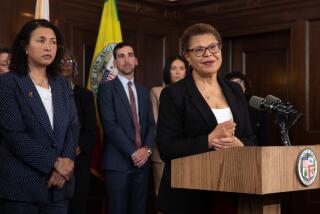Editorial: Jobs building local transit projects should go to the communities paying for them
When Los Angeles County voted last November to increase the sales tax again to pay for more rail lines, buses and highway improvements, one of the selling points was that the revenue would fund a transportation building boom and create lots and lots of new jobs — more than 465,000 of them, by one estimate.
For the last several years, the Los Angeles County Metropolitan Transportation Authority has sought to steer more of the jobs created by local taxpayer-funded projects to local residents who need them. Taking advantage of a pilot program created by the Obama administration, Metro required contractors to hire at least 40% of their workers from low-income areas within five miles of the project, and an additional 10% from the ranks of “disadvantaged” workers, including men and women on public assistance, Iraq or Afghanistan war veterans, felons, and young people leaving the foster care system.
The idea was to maximize the return on the taxpayers’ investment: Build a modern transportation system, create lots of solid middle-class jobs for residents and provide career opportunities for people who have struggled to find work.
But now President Trump is looking to roll back local-hire programs nationwide and return to the days when the federal government banned geographical hiring targets.
President Trump is looking to roll back local-hire programs nationwide and return to the days when the federal government banned geographical hiring targets.
Earlier this month, the U.S. Department of Transportation announced it will withdraw a rule proposed by the Obama administration to allow local hiring preferences in more federally funded transportation projects. The proposal was based on the pilot program, which was created in 2015 to test whether local hiring edicts hurt competition. The pilot is set to run until 2022, but Metro and local hire advocates fear the Trump administration may terminate that too.
The federal government has long barred cities and states from imposing local-hire mandates on projects that receive federal funds. The rationale was that if taxpayers nationwide paid for the project, workers nationwide should have a chance at being hired to build it.
The ban made more sense when the federal government covered 80% of the cost of building highways and rail lines. But that’s not the case anymore — especially not in urban areas such as L.A. County, where voters have raised their local taxes to build more infrastructure. Now the federal government is just a contributor, not the primary funder, and it shouldn’t be able to bar local transportation agencies from favoring the taxpayers who are footing the majority of the bill.
Take, for example, the $2-billion Crenshaw light rail line, which is 90% funded by local tax dollars. The line runs through South Los Angeles communities with low incomes and high unemployment; community leaders pushed Metro to put those residents to work on the project. So far, the contractor building the line has exceeded Metro’s goals — 59% of those hired have been local, and 12% have been disadvantaged workers.
Ending local hiring mandates could make it much harder for people like Jason Taylor to get a foothold on a career ladder. With a felony conviction on his record, Taylor, 39, struggled to find a stable, good-paying job. The customer service and sales gigs he landed paid $11 or $12 an hour — hardly enough to cover the cost of housing and other expenses in his mid-city neighborhood. With the help of nonprofits, he entered a carpentry training program and got hired as an apprentice by the contractor building the Crenshaw Line. Now he has a full-time job helping build the project. He has healthcare and retirement benefits and is one year away from becoming a journeyman carpenter, which pays $42 an hour.
Critics of local hire argue that the regulations are burdensome, hinder competition for jobs and raise taxpayers’ costs. The Obama administration’s pilot was designed to test those arguments, exploring whether local hiring preferences and efforts to create career pathways in impoverished communities are ultimately a net benefit or a waste of taxpayer dollars. Like California, Texas, Illinois, Minnesota and other states all have projects underway testing the effects of geographic, economic and social hiring preferences.
Given the encouraging results from Metro, cities and states — which are increasingly picking up the lion’s share of the cost of transportation projects — should be allowed to continue experimenting with local hire. Using infrastructure dollars to build badly needed transportation improvements and a new middle class would truly help make America great again.
Follow the Opinion section on Twitter @latimesopinion and Facebook
More to Read
A cure for the common opinion
Get thought-provoking perspectives with our weekly newsletter.
You may occasionally receive promotional content from the Los Angeles Times.






